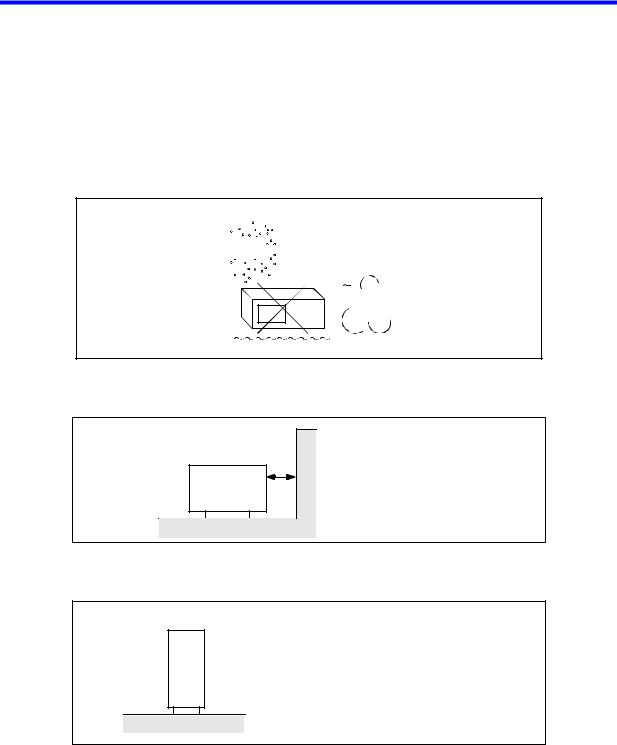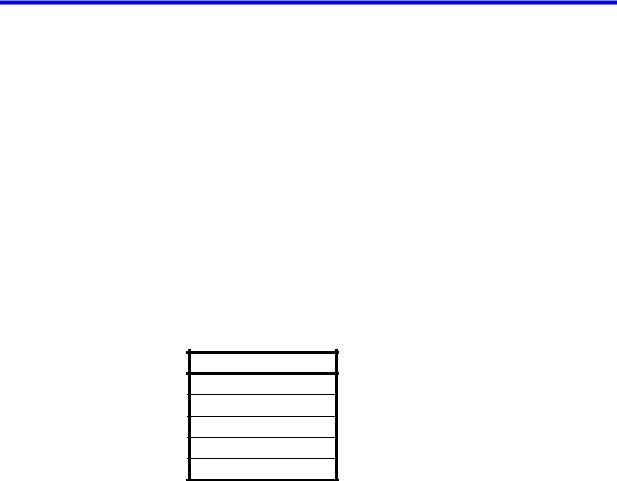Advantest r3264, r3267, r3273 schematic

R3267 Series
Spectrum Analyzer
Operation Manual (Vol.2)
MANUAL NUMBER FOE-8335034D00
Applicable models
R3264
R3267
R3273
|
C 1998 ADVANTEST CORPORATION |
First printing October 1, 1998 |
|
|
All rights reserved. |
Printed in Japan |
|
|
|
|
|
|
|
|
|

No. ESF00
Safety Summary
To ensure thorough understanding of all functions and to ensure efficient use of this instrument, please read the manual carefully before using. Note that Advantest bears absolutely no responsibility for the result of operations caused due to incorrect or inappropriate use of this instrument.
If the equipment is used in a manner not specified by Advantest, the protection provided by the equipment may be impaired.
•Warning Labels
Warning labels are applied to Advantest products in locations where specific dangers exist. Pay careful attention to these labels during handling. Do not remove or tear these labels. If you have any questions regarding warning labels, please ask your nearest Advantest dealer. Our address and phone number are listed at the end of this manual.
Symbols of those warning labels are shown below together with their meaning.
DANGER: Indicates an imminently hazardous situation which will result in death or serious personal injury.
WARNING: Indicates a potentially hazardous situation which will result in death or serious personal injury.
CAUTION: Indicates a potentially hazardous situation which will result in personal injury or a damage to property including the product.
•Basic Precautions
Please observe the following precautions to prevent fire, burn, electric shock, and personal injury.
•Use a power cable rated for the voltage in question. Be sure however to use a power cable conforming to safety standards of your nation when using a product overseas.
•When inserting the plug into the electrical outlet, first turn the power switch OFF and then insert the plug as far as it will go.
•When removing the plug from the electrical outlet, first turn the power switch OFF and then pull it out by gripping the plug. Do not pull on the power cable itself. Make sure your hands are dry at this time.
•Before turning on the power, be sure to check that the supply voltage matches the voltage requirements of the instrument.
•Be sure to plug the power cable into an electrical outlet which has a safety ground terminal. Grounding will be defeated if you use an extension cord which does not include a safety ground terminal.
•Be sure to use fuses rated for the voltage in question.
•Do not use this instrument with the case open.
•Do not place objects on top of this product. Also, do not place flower pots or other containers containing liquid such as chemicals near this product.
Safety-1

Safety Summary
•When the product has ventilation outlets, do not stick or drop metal or easily flammable objects into the ventilation outlets.
•When using the product on a cart, fix it with belts to avoid its drop.
•When connecting the product to peripheral equipment, turn the power off.
•Caution Symbols Used Within this Manual
Symbols indicating items requiring caution which are used in this manual are shown below together with their meaning.
DANGER: Indicates an item where there is a danger of serious personal injury (death or serious injury).
WARNING: Indicates an item relating to personal safety or health.
CAUTION: Indicates an item relating to possible damage to the product or instrument or relating to a restriction on operation.
•Safety Marks on the Product
The following safety marks can be found on Advantest products.
:ATTENTION - Refer to manual.
:Protective ground (earth) terminal.
:DANGER - High voltage.
:CAUTION - Risk of electric shock.
•Replacing Parts with Limited Life
The following parts used in the instrument are main parts with limited life. Replace the parts listed below after their expected lifespan has expired.
Note that the estimated lifespan for the parts listed below may be shortened by factors such as the environment where the instrument is stored or used, and how often the instrument is used. The parts inside are not user-replaceable. For a part replacement, please contact the Advantest sales office for servicing.
There is a possibility that each product uses different parts with limited life. For more information, refer to Chapter 1.
Safety-2

Safety Summary
Main Parts with Limited Life
|
Part name |
|
Life |
|
|
|
|
|
Unit power supply |
|
5 years |
|
|
|
|
|
Fan motor |
|
5 years |
|
|
|
|
|
Electrolytic capacitor |
|
5 years |
|
|
|
|
|
LCD display |
|
6 years |
|
|
|
|
|
LCD backlight |
|
2.5 years |
|
|
|
|
|
Floppy disk drive |
|
5 years |
|
|
|
|
• Hard Disk Mounted Products |
|
||
|
The operational warnings are listed below. |
|
|
•Do not move, shock and vibrate the product while the power is turned on.
Reading or writing data in the hard disk unit is performed with the memory disk turning at a high speed. It is a very delicate process.
•Store and operate the products under the following environmental conditions. An area with no sudden temperature changes.
An area away from shock or vibrations. An area free from moisture, dirt, or dust.
An area away from magnets or an instrument which generates a magnetic field.
•Make back-ups of important data.
The data stored in the disk may become damaged if the product is mishandled. The hard disc has a limited life span which depends on the operational conditions. Note that there is no guarantee for any loss of data.
•Precautions when Disposing of this Instrument
When disposing of harmful substances, be sure dispose of them properly with abiding by the state-provided law.
Harmful substances: (1) PCB (polycarbon biphenyl)
(2)Mercury
(3)Ni-Cd (nickel cadmium)
(4)Other
Items possessing cyan, organic phosphorous and hexadic chromium and items which may leak cadmium or arsenic (excluding lead in sol der).
Example: |
fluorescent tubes, batteries |
Safety-3

Environmental Conditions
This instrument should be only be used in an area which satisfies the following conditions:
•An area free from corrosive gas
•An area away from direct sunlight
•A dust-free area
•An area free from vibrations
Direct sunlight
 Dust
Dust

 Corrosive
Corrosive
gas
Vibration
Figure-1 Environmental Conditions
•Operating position
Front |
Keep at least 10 centimeters of space between the rear panel and any other surface
Figure-2 Operating Position
•Storage position
Front
This instrument should be stored in a horizontal position.
When placed in a vertical (upright) position for storage or transportation, ensure the instrument is stable and secure.
-Ensure the instrument is stable. -Pay special attention not to fall.
Figure-3 Storage Position
This instrument can be used safely under the following conditions:
•Altitude of up to 2000 m
•Installation Categories II
•Pollution Degree
Safety-4

R3267 Series Spectrum Analyzer Operation Manual (Vol.2)
PREFACE
This manual (VOL.2) describes how to test the performance of the R3267 Series.
A separate volume (VOL.1) describes the operations, performance and remote programming of the R3267 Series.
(1) Configuration of this manual
1. Performance Verification |
Describes how to test performance. |
|
|
(2)Typeface conventions used in this manual
•Panel keys and soft keys are printed in a contrasting typestyle to make them stand out from the text as follows:
Panel keys: Boldface type |
Example: FREQ, FORMAT |
Soft keys: Boldface and italic type |
Example: Center, Trace Detector |
•When a series of key operations are described using a comma between two keys.
•There are various soft menus used to switch between two states such as ON/OFF and AUTO/MNL. For example, when turning off the Display ON/OFF function, the annotation "Display ON/ OFF(OFF)" is used.
When switching the RBW AUTO/MNL function to MNL, the annotation "RBW AUTO/MNL(MNL)" is used.
Preface-1

R3267 Series Spectrum Analyzer Operation Manual (Vol.2)
TABLE OF CONTENTS
1 |
PERFORMANCE VERIFICATION .......................................................... |
1-1 |
1.1 |
Preparation ........................................................................................................... |
1-1 |
1.2 |
Procedure ............................................................................................................. |
1-4 |
1.2.1 Frequency Reference Output Accuracy ........................................................ |
1-4 |
|
1.2.2Frequency Reference Output Accuracy
|
(when the OPT21, OPT22 and OPT23 are installed) ................................... |
1-6 |
1.2.3 |
Accuracy of Frequency Readout and Frequency Counter ............................ |
1-8 |
1.2.4 |
Frequency Span Accuracy ............................................................................ |
1-11 |
1.2.5 |
Calibration Amplitude Accuracy .................................................................. |
1-14 |
1.2.6 |
IF Gain Uncertainty ...................................................................................... |
1-15 |
1.2.7 |
Input Attenuator Switching Accuracy .......................................................... |
1-18 |
1.2.8 |
Frequency Response ..................................................................................... |
1-21 |
1.2.9 |
Scale Fidelity ................................................................................................ |
1-26 |
1.2.10 |
RBW Switching Uncertainty ........................................................................ |
1-31 |
1.2.11 RBW Accuracy and Selectivity ................................................................... |
1-33 |
|
1.2.12 |
Noise Sidebands ............................................................................................ |
1-36 |
1.2.13 |
Displayed Average Noise Level ................................................................... |
1-39 |
1.2.14 |
Residual FM .................................................................................................. |
1-43 |
1.2.15 |
Residual Response ........................................................................................ |
1-46 |
1.2.16 |
Gain Compression ......................................................................................... |
1-49 |
1.2.17 |
Second Harmonic Distortion ........................................................................ |
1-53 |
1.2.18 |
Third Order Intermodulation Distortion ....................................................... |
1-57 |
1.2.19 |
Image, Multiple and Out of Band Responses (For the R3267/73) ............... |
1-62 |
1.2.20 |
Sweep Time Accuracy .................................................................................. |
1-68 |
1.3 Performance Check Sheet .................................................................................... |
1-71 |
|
1.3.1 |
Frequency Reference Output Accuracy ........................................................ |
1-71 |
1.3.2 |
Frequency Readout Accuracy and Frequency Counter Marker .................... |
1-71 |
1.3.3 |
Frequency Span Accuracy ............................................................................ |
1-72 |
1.3.4 |
Calibration Amplitude Accuracy .................................................................. |
1-73 |
1.3.5 |
IF Gain Uncertainty ...................................................................................... |
1-73 |
1.3.6 |
Input Attenuator Accuracy ............................................................................ |
1-75 |
1.3.7 |
Frequency Response ..................................................................................... |
1-76 |
1.3.8 |
Scale Fidelity ................................................................................................ |
1-84 |
1.3.9 |
Resolution Bandwidth Switching ................................................................. |
1-85 |
1.3.10 |
Resolution Bandwidth Accuracy and Selectivity ......................................... |
1-86 |
1.3.11 |
Noise Sidebands ............................................................................................ |
1-86 |
1.3.12 |
Displayed Average Noise Level ................................................................... |
1-87 |
1.3.13 |
Residual FM .................................................................................................. |
1-87 |
1.3.14 |
Residual Response ........................................................................................ |
1-87 |
1.3.15 |
Gain Compression ......................................................................................... |
1-88 |
1.3.16 |
Second Harmonics Distortion ....................................................................... |
1-88 |
1.3.17 |
Third Order Intermodulation Distortion ....................................................... |
1-88 |
C-1

R3267 Series Spectrum Analyzer Operation Manual (Vol.2)
Table of Contents
1.3.18 |
Image, Multiple, Out of Band ....................................................................... |
1-89 |
1.3.19 |
Sweep Time Accuracy .................................................................................. |
1-90 |
ALPHABETICAL INDEX .................................................................................... |
I-1 |
|
C-2

R3267 Series Spectrum Analyzer Operation Manual (Vol.2)
LIST OF ILLUSTRATIONS
No. |
|
Title |
|
Page |
|
|
|
|
|
1-1 |
|
Setup for Measuring a Frequency Reference Output Accuracy ....................................... |
1-5 |
|
1-2 |
|
Connections for Measuring the Frequency Reference Output Accuracy |
|
|
|
|
(when the OPT21, OPT22 and OPT23 are installed) ....................................................... |
1-6 |
|
1-3 |
|
Setup for Measuring a Frequency Readout Accuracy and Frequency Counter ................ |
1-8 |
|
1-4 |
|
Setup for Measuring a Frequency Span Accuracy ............................................................ |
1-11 |
|
1-5 |
|
Setup for Measuring a IF Gain Uncertainty ...................................................................... |
1-15 |
|
1-6 |
|
Setup for Measuring an Input Attenuator Accuracy ......................................................... |
1-19 |
|
1-7 |
|
Setup for Measuring a Frequency Response ..................................................................... |
1-22 |
|
1-8 |
|
Setup for Measuring a Scale Fidelity ................................................................................ |
1-26 |
|
1-9 |
|
Setup for Measuring a Noise Sidebands ........................................................................... |
1-37 |
|
1-10 |
|
Setup for Measuring a Residual FM ................................................................................. |
1-43 |
|
1-11 |
|
Setup for the Gain Compression ....................................................................................... |
1-50 |
|
1-12 |
|
Setup for Measuring a Second Harmonics Distortion ...................................................... |
1-54 |
|
1-13 |
|
Setup for Measuring a Third Order Intermodulation Distortion ....................................... |
1-58 |
|
1-14 |
|
Setup for Measuring a Image, Multiple, Out of Band ...................................................... |
1-62 |
|
1-15 |
|
Setup for Measuring a Sweep Time Accuracy ................................................................. |
1-68 |
|
F-1

R3267 Series Spectrum Analyzer Operation Manual (Vol.2)
List of Tables
No. |
|
Title |
|
Page |
|
|
|
|
|
1-1 |
|
Instrument Required ......................................................................................................... |
1-1 |
|
1-2 |
|
Frequency Span Setting at a Center Frequency of 2 GHz ................................................ |
1-9 |
|
1-3 |
|
Center/Span Frequencies for the R3267 ........................................................................... |
1-12 |
|
1-4 |
|
Center/Span Frequencies for the R3273 ........................................................................... |
1-13 |
|
1-5 |
|
IF Gain Uncertainty Setting .............................................................................................. |
1-17 |
|
1-6 |
|
RBW Setting ..................................................................................................................... |
1-17 |
|
1-7 |
|
Input Attenuator Setting .................................................................................................... |
1-20 |
|
1-8 |
|
1 dB Step Scale Fidelity Setting ....................................................................................... |
1-28 |
|
1-9 |
|
HP8495H and HP3325B Settings ..................................................................................... |
1-29 |
|
1-10 |
|
Settings on the HP3325B in relation to the Reference Output Level ............................... |
1-30 |
|
1-11 |
|
RBW Switching Uncertainty Setting ................................................................................ |
1-32 |
|
1-12 |
|
3 dB Band Width Setting .................................................................................................. |
1-34 |
|
1-13 |
|
60 dB Band Width Setting ................................................................................................ |
1-35 |
|
1-14 |
|
Offset Setting at a Center Frequency of 1 GHz ............................................................... |
1-38 |
|
1-15 |
|
Center Frequency Setting for Displayed Average Noise Level ........................................ |
1-41 |
|
1-16 |
|
Start and Stop Frequencies Setting ................................................................................... |
1-42 |
|
1-17 |
|
Third Order Intermodulation Distortion ........................................................................... |
1-59 |
|
1-18 |
|
Third Order Intermodulation Distortion (When the Preselector is Used) ....................... |
1-61 |
|
1-19 |
|
Image, Multiple, Out of Band Setting (Center Frequency: 2 GHz) .................................. |
1-64 |
|
1-20 |
|
Image, Multiple, Out of Band Setting for the R3273 ....................................................... |
1-65 |
|
1-21 |
|
Image, Multiple, Out of Band Setting for the R3267 ....................................................... |
1-66 |
|
1-22 |
|
Sweep Time Setting .......................................................................................................... |
1-70 |
|
T-1

R3267 Series Spectrum Analyzer Operation Manual (Vol.2)
1.1 Preparation
1 PERFORMANCE VERIFICATION
This chapter explains how to check the R3267 Series. We recommend that you have a copy of the performance check sheet with you when performing these checks. If a problem occurs with the R3267 Series, contact ADVANTEST service center with measurement data filled out on the performance check sheet (including the model, serial number and so on). For information on how to ship the R3267 Series for repairs, refer to Section 1.5.3, "Transporting" in Vol.1.
NOTE: Perform the CAL ALL before starting this performance verification tests.
1.1Preparation
This chapter decribes the instruments using on this performance verification tests.
NOTE:
1.The R3267 Series to be tested should be warmed up for at least 30 minutes before starting tests. Any additional instrument used for this performance verification tests should be warmed up as appropriate.
2.Make sure that the test instrument used meets its own published specifications and that all connectors are clean, before starting test. All connectors should be firmly connected.
Table 1-1 Instrument Required (1 of 3)
No. |
Instrument |
Specification |
Recommended |
Quantity |
|
Model |
|||||
|
|
|
|
||
|
|
|
|
|
|
1 |
Frequency |
Output Frequency: |
R3031 |
1 |
|
|
Standard |
10 MHz |
ADVANTEST |
|
|
|
|
Stability: 5× 10-10/ day |
|
|
|
|
|
Output Impedance: 50 |
|
|
|
|
|
Ω Output Level: |
|
|
|
|
|
1 Vpp or more |
|
|
|
|
|
|
|
|
|
2 |
Frequency |
Resolution: 0.1 Hz |
R5372 |
1 |
|
|
Counter |
|
ADVANTEST |
|
|
|
|
|
|
|
|
3 |
Signal Generator |
Frequency Range: |
SMP02 |
1 |
|
|
|
10 MHz to 18 GHz |
(with B11 option) |
|
|
|
|
Output Level: |
Rohde&Schwarz |
|
|
|
|
-15 dBm to +10 dBm |
|
|
|
|
|
Stability: 1× 10-6/ year |
|
|
|
|
|
|
|
|
|
4 |
Signal Generator |
Frequency Range: |
SMP03 |
1 |
|
|
|
10 MHz to 27 GHz |
(with B11 option) |
|
|
|
|
Output Level: |
Rohde&Schwarz |
|
|
|
|
-15 dBm to +10 dBm |
|
|
|
|
|
Stability: 1× 10-6/ year |
|
|
1-1

R3267 Series Spectrum Analyzer Operation Manual (Vol.2)
1.1 Preparation
Table 1-1 Instrument Required (2 of 3)
No. |
Instrument |
Specification |
Recommended |
Quantity |
|
Model |
|||||
|
|
|
|
||
|
|
|
|
|
|
5 |
Signal Generator |
Frequency Range: |
HP8663A |
1 |
|
|
|
10 MHz to 2.5 GHz |
Hewlett Packard |
|
|
|
|
Output Level: |
|
|
|
|
|
-20 dBm to +10 dBm |
|
|
|
|
|
Residual SSB |
|
|
|
|
|
Phase Noise |
|
|
|
|
|
at 1 kHz offset: |
|
|
|
|
|
less than -115 dBc/Hz |
|
|
|
|
|
at 10 kHz offset: |
|
|
|
|
|
less than -124 dBc/Hz |
|
|
|
|
|
at 100 kHz offset: |
|
|
|
|
|
less than -130 dBc/Hz |
|
|
|
|
|
|
|
|
|
6 |
Function |
Frequency Range: |
HP3325B |
1 |
|
|
Generator |
10 mHz to 20 MHz |
Hewlett Packard |
|
|
|
|
Output Level: |
|
|
|
|
|
-10 dBm to +13 dBm |
|
|
|
|
|
Stability: 5× 10-6/ year |
|
|
|
|
|
|
|
|
|
7 |
Power Meter |
Frequency Range: |
NRVS |
1 |
|
|
Power Sensor |
10 MHz to 26.5 GHz |
NRV-Z52 |
|
|
|
|
Input Level: |
Rohde&Schwarz |
|
|
|
|
1µ W to 100 mW |
|
|
|
|
|
Maximum SWR: |
|
|
|
|
|
1.25 (26.5 GHz) |
|
|
|
|
|
|
|
|
|
8 |
1 dB Step |
Attenuation Range: |
HP8494H |
1 |
|
|
Attenuator |
0 dB to 12 dB |
Hewlett Packard |
|
|
|
|
Frequency Range: |
|
|
|
|
|
DC to 18 GHz |
|
|
|
|
|
|
|
|
|
9 |
10 dB Step |
Attenuation Range: |
HP8495H |
1 |
|
|
Attenuator |
0 dB to 70 dB |
Hewlett Packard |
|
|
|
|
Frequency Range: |
|
|
|
|
|
DC to 18 GHz |
|
|
|
|
|
|
|
|
|
10 |
Attenuator Driver |
|
HP11713A |
1 |
|
|
|
|
Hewlett Packard |
|
|
|
|
|
|
|
|
11 |
Terminator |
Impedance: 50 Ω |
RNA |
1 |
|
|
|
|
Rohde&Schwarz |
|
|
|
|
|
|
|
|
12 |
3 dB Attenuator |
Impedance: 50 Ω |
DEF-000685-1 |
1 |
|
|
|
Attenuation: 3 dB |
ADVANTEST |
|
|
|
|
SMA(m)-SMA(f) |
|
|
|
|
|
|
|
|
|
13 |
20 dB Attenuator |
Impedance: 50 Ω |
DEE-000480-1 |
1 |
|
|
|
Attenuation: 20 dB |
ADVANTEST |
|
|
|
|
SMA(m)-SMA(f) |
|
|
|
|
|
|
|
|
1-2

R3267 Series Spectrum Analyzer Operation Manual (Vol.2)
1.1 Preparation
Table 1-1 Instrument Required (3 of 3)
No. |
Instrument |
Specification |
Recommended |
Quantity |
|
Model |
|||||
|
|
|
|
||
|
|
|
|
|
|
14 |
Power Splitter |
Frequency Range: |
1579 |
1 |
|
|
|
10 MHz to 26.5 GHz |
Weinschel |
|
|
|
|
Insertion Loss: |
|
|
|
|
|
6 dB (nominal) |
|
|
|
|
|
|
|
|
|
15 |
Power Devider |
Frequency Range: |
DDUL-20A-100 |
1 |
|
|
|
20 MHz to 1.5 GHz |
Merrimac |
|
|
|
|
Isolation: |
|
|
|
|
|
greater than 18 dB |
|
|
|
|
|
|
|
|
|
16 |
Power Devider |
Frequency Range: |
DDUL-24M-10G |
1 |
|
|
|
2 GHz to 18 GHz |
Merrimac |
|
|
|
|
Isolation: |
|
|
|
|
|
greater than 18 dB |
|
|
|
|
|
|
|
|
|
17 |
Low-pass Filter |
Cutoff Frequency: |
DEE-001172-1 |
1 |
|
|
|
2.2 GHz |
ADVANTEST |
|
|
|
|
Rejection (3 GHz): |
|
|
|
|
|
greater than 40 dB |
|
|
|
|
|
Rejection (3.8 GHz): |
|
|
|
|
|
greater than 80 dB |
|
|
|
|
|
|
|
|
|
18 |
RF Cable |
Impedance: 50 Ω |
MI-09 |
2 |
|
|
|
BNC(m)-BNC(m) |
ADVANTEST |
|
|
|
|
Length: |
|
|
|
|
|
Approx. 1.5 m |
|
|
|
|
|
|
|
|
|
19 |
RF Cable |
Impedance: 50 Ω |
A01002 |
3 |
|
|
|
SMA(m)-SMA(m) |
ADAVNTEST |
|
|
|
|
Frequency Range: |
|
|
|
|
|
DC to 26.5 GHz |
|
|
|
|
|
Maximum SWR: |
|
|
|
|
|
1.45 at 26.5 GHz |
|
|
|
|
|
Length: |
|
|
|
|
|
Approx. 0.7 m |
|
|
|
|
|
|
|
|
|
20 |
Adapter |
N(m)-SMA(f) |
Generic |
5 |
|
|
|
|
|
|
|
21 |
Adapter |
SMA(f)-SMA(f) |
Generic |
1 |
|
|
|
|
|
|
|
22 |
Adapter |
N(f)-BNC(m) |
Generic |
1 |
|
|
|
|
|
|
|
23 |
Adapter |
N(m)-BNC(f) |
Generic |
3 |
|
|
|
|
|
|
1-3

R3267 Series Spectrum Analyzer Operation Manual (Vol.2)
1.2 Procedure
1.2Procedure
This section describes the method of how to test the performance verification of the R3267 Series.
NOTE: In the following procedure, the values used are for the recommended instruments.
When using other instruments, use the values conforming to the specifications of each instrument.
1.2.1Frequency Reference Output Accuracy
This section explains how to check the reference frequency accuracy of the spectrum analyzer using the calibration signal.
For checking the frequency reference output accuracy when the OPT21, OPT22 and OPT23 are installed, refer to Section 1.2.2, "Frequency Reference Output Accuracy (when the OPT21, OPT22 and OPT23 are installed)."
CAUTION: |
If the frequency reference of the R3267 Series is set to EXT, perform 15 minutes warm-up opera- |
||||
|
|
tion after instrument preset. |
|
|
|
|
|
|
|
|
|
Specifications: |
|
|
|
|
|
30 MHz ± 3 Hz |
|
|
|
||
Instruments Required |
|
|
|
||
|
|
|
|
|
|
|
|
Instruments |
QTY |
Recommended Model |
|
|
|
|
|
|
|
|
Frequency Standard |
1 |
R3031 |
|
|
|
|
|
|
|
|
|
Frequency Counter |
1 |
R5372 |
|
|
|
|
|
|
|
|
|
RF Cable BNC(m)-BNC(m) |
2 |
MI-09 |
|
|
|
|
|
|
|
|
|
Adapter N(m)-BNC(f) |
1 |
|
|
|
|
|
|
|
|
|
1-4

R3267 Series Spectrum Analyzer Operation Manual (Vol.2)
1.2.1 Frequency Reference Output Accuracy
Procedures:
Setup
1.Connect the frequency counter and the frequency standard as shown in Figure 1- 1.
Figure 1-1 Setup for Measuring a Frequency Reference Output Accuracy
Setting the Frequency Counter
2. Set the R5372 controls as follows:
Input: |
B |
Resolution: |
0.1 Hz |
10 MHz Reference: |
External |
Initialization
3.Press SHIFT and CONFIG(PRESET).
4.Wait for the frequency counter to settle down.
5.Record the counter reading on the performance check sheet.
1-5

R3267 Series Spectrum Analyzer Operation Manual (Vol.2)
1.2.2 Frequency Reference Output Accuracy (when the OPT21, OPT22 and OPT23 are installed)
1.2.2Frequency Reference Output Accuracy
(when the OPT21, OPT22 and OPT23 are installed)
This section explains how to check the frequency reference output accuracy when the OPT21, OPT22 and OPT23 are installed. Input the signal from the signal generator into the spectrum analyzer, and measure it using the counter function of the spectrum analyzer.
CAUTION: If the frequency reference of the R3267 Series is set to EXT, perform 15 minutes warm-up operation after instrument preset.
Specifications:
1 GHz ± 80Hz (OPT21)
1 GHz ± 20Hz (OPT22)
1 GHz ± 5Hz (OPT23)
Instruments Required
Instruments |
QTY |
Recommended Model |
|
|
|
Frequency Standard |
1 |
R3031 |
|
|
|
Signal Generator |
1 |
SMP03 |
|
|
|
RF Cable BNC(m)-BNC(m) |
1 |
A01002 |
|
|
|
RF Cable SMA(m)-SMA(m) |
1 |
MI-09 |
|
|
|
Adapter N(m)-SMA(f) |
1 |
|
|
|
|
Procedures:
Setup
1.Connect the signal generator as shown in Figure 1-2.
Figure 1-2 Connections for Measuring the Frequency Reference Output
Accuracy (when the OPT21, OPT22 and OPT23 are installed)
1-6

R3267 Series Spectrum Analyzer Operation Manual (Vol.2)
1.2.2 Frequency Reference Output Accuracy (when the OPT21, OPT22 and OPT23 are installed)
Initialization
2.Press SHIFT and CONFIG(PRESET).
Measurement using a center frequency of 1 GHz
3.Set the SMP03 controls as follows:
Frequency: |
1 GHz |
Output level: |
-10 dBm |
10 MHz Reference: |
External |
4.Press FREQ, 1 and GHz.
5.Press SPAN, 1 and MHz.
6.Press SCRH.
7.Press MEAS, Counter and Resolution 1 Hz.
8.Press Counter ON/OFF(ON).
9.Record the frequency of the counter marker reading on the performance check sheet.
10.Press Counter ON/OFF(OFF).
1-7

R3267 Series Spectrum Analyzer Operation Manual (Vol.2)
1.2.3 Accuracy of Frequency Readout and Frequency Counter
1.2.3Accuracy of Frequency Readout and Frequency Counter
This section explains how to check the accuracy of the frequency readout and frequency counter using the signal generator.
Specifications: |
|
|
|
|
|
Accuracy of Frequency Readout |
|
|
|
|
± (0.01 × Frequency span + 0.15 × |
Resolution bandwidth + 10 Hz) |
||
|
Accuracy of Frequency Counter marker |
SPAN < 1 GHz : S/N > 25 dB |
||
|
± (5 Hz × N + 1 LSD) |
|
|
|
|
N: Harmonic order |
|
|
|
Instruments Required |
|
|
|
|
|
|
|
|
|
|
Instruments |
|
QTY |
Recommended Model |
|
|
|
|
|
|
Signal Generator |
|
1 |
SMP03 |
|
|
|
|
|
|
RF Cable BNC(m)-BNC(m) |
|
1 |
A01002 |
|
|
|
|
|
|
RF Cable SMA(m)-SMA(m) |
|
1 |
MI-09 |
|
|
|
|
|
|
Adapter N(m)-SMA(f) |
|
1 |
|
|
|
|
|
|
Procedures:
Setup
1.Connect the signal generator as shown in Figure 1-3.
Figure 1-3 Setup for Measuring a Frequency Readout Accuracy and
Frequency Counter
Initialization
2.Press SHIFT and CONFIG(PRESET).
1-8

R3267 Series Spectrum Analyzer Operation Manual (Vol.2)
1.2.3 Accuracy of Frequency Readout and Frequency Counter
Measurement using a center frequency of 2 GHz
3.Set the SMP03 controls as follows:
Frequency: |
2 GHz |
Output level: |
-10 dBm |
10 MHz Reference: |
External |
4.Press FREQ, 2 and GHz.
5.Press SPAN, 1 and MHz.
6.Press SCRH.
7.Record the frequency of the marker reading on the performance check sheet.
8.Repeat steps 5 through 7 for each frequency setting listed on Table 1-2.
Table 1-2 Frequency Span Setting at a Center Frequency of 2 GHz
Frequency span
10 MHz
20 MHz
50 MHz
100 MHz
2 GHz
Frequency measurement using the counter marker
9.Press SPAN, 1 and MHz.
10.Press SRCH.
11.Press MEAS, Counter and Resolution 1 Hz.
12.Press Counter ON/OFF(ON).
13.Record the frequency of the counter marker reading on the performance check sheet.
14.Press Counter ON/OFF(OFF).
For the R3267/73
Measurement using a center frequency of 5 GHz
15.Set both the frequency on the SMP03 and the center frequency to 5 GHz and repeat steps 3 through 14.
1-9

R3267 Series Spectrum Analyzer Operation Manual (Vol.2)
1.2.3 Accuracy of Frequency Readout and Frequency Counter
For the R3273 only
Measurement using a center frequency of 11 GHz and 18 GHz
16.Set the frequency on the SMP03 and the center frequency to 11 GHz and repeat steps 3 through 14.
17.Set the frequency on the SMP03 and the center frequency to 18 GHz and repeat steps 3 through 14.
1-10

R3267 Series Spectrum Analyzer Operation Manual (Vol.2)
1.2.4 Frequency Span Accuracy
1.2.4Frequency Span Accuracy
This section explains how to check the frequency span accuracy using signals from the signal generator and the delta marker.
Check the span accuracy using the signal frequency difference measured with the delta marker function.
Specifications:
less than ± 1 % of the frequency span setting
Instruments Required
Instruments |
QTY |
Recommended Model |
|
|
|
Signal Generator |
1 |
SMP03 |
|
|
|
RF Cable BNC(m)-BNC(m) |
1 |
A01002 |
|
|
|
RF Cable SMA(m)-SMA(m) |
1 |
MI-09 |
|
|
|
Adapter N(m)-SMA(f) |
1 |
|
|
|
|
Procedures:
Setup
1.Connect the signal generator as shown in Figure 1-4.
Figure 1-4 Setup for Measuring a Frequency Span Accuracy
Setting the signal generator
2.Set the SMP03 controls as follows:
Output level: |
-5 dBm |
10 MHz Reference: |
External |
Initialization
3.Press SHIFT and CONFIG(PRESET).
1-11

R3267 Series Spectrum Analyzer Operation Manual (Vol.2)
1.2.4 Frequency Span Accuracy
Measurement of the span accuracy
4.Set the frequency of the SMP03 to 1.999992 GHz.
5.Press FREQ, 2 and GHz.
6.Press SPAN, 2, 0 and kHz.
7.Press SINGLE.
8.Press SRCH, after the sweep has completed.
9.Press MKR, Delta Marker and Delta Marker ON/OFF (ON).
10.Set the frequency of the SMP03 to 2.000008 GHz.
11.Press SINGLE.
12.Press SRCH, after the sweep has completed.
13.Record the frequency of the delta marker reading on the performance check sheet.
14.Repeat steps 4 through 13 for each frequency setting listed on Table 1-3.
Table 1-3 Center/Span Frequencies for the R3267
SMP03 |
SMP03 |
Center |
Frequency |
Remarks |
1st Frequency |
2nd Frequency |
Frequency |
Span |
|
|
|
|
|
|
1.999980 GHz |
2.000020 GHz |
2 GHz |
50 kHz |
|
|
|
|
|
|
1.999940 GHz |
2.000160 GHz |
2 GHz |
400 kHz |
|
|
|
|
|
|
1.9992 GHz |
2.0008 GHz |
2 GHz |
2 MHz |
|
|
|
|
|
|
1.998 GHz |
2.002 GHz |
2 GHz |
5 MHz |
|
|
|
|
|
|
1.996 GHz |
2.004 GHz |
2 GHz |
10 MHz |
|
|
|
|
|
|
1.992 GHz |
2.008 GHz |
2 GHz |
20 MHz |
|
|
|
|
|
|
1.98 GHz |
2.02 GHz |
2 GHz |
50 MHz |
|
|
|
|
|
|
1.96 GHz |
2.04 GHz |
2 GHz |
100 MHz |
|
|
|
|
|
|
1.92 GHz |
2.08 GHz |
2 GHz |
200 MHz |
|
|
|
|
|
|
1.8 GHz |
2.2 GHz |
2 GHz |
500 MHz |
|
|
|
|
|
|
1.6 GHz |
2.4 GHz |
2 GHz |
1 GHz |
|
|
|
|
|
|
1.2 GHz |
2.8 GHz |
2 GHz |
2 GHz |
|
|
|
|
|
|
2.4 GHz |
5.6 GHz |
4 GHz |
4 GHz |
R3267/73 |
|
|
|
|
|
0.8 GHz |
7.2 GHz |
4 GHz |
8 GHz |
R3267/73 |
|
|
|
|
|
1-12

R3267 Series Spectrum Analyzer Operation Manual (Vol.2)
1.2.4 Frequency Span Accuracy
For the R3273 only
Measurement for a center frequency of 10 GHz and 17 GHz.
15.Repeat steps 4 through 13 for each frequencies setting listed on Table 1-4.
Table 1-4 Center/Span Frequencies for the R3273
SMP03 |
SMP03 |
Center |
Frequency |
1st Frequency |
2nd Frequency |
Frequency |
Span |
|
|
|
|
9.996 GHz |
10.004 GHz |
10 GHz |
10 MHz |
|
|
|
|
9.96 GHz |
10.04 GHz |
10 GHz |
100 MHz |
|
|
|
|
9.6 GHz |
10.4 GHz |
10 GHz |
1 GHz |
|
|
|
|
9.2 GHz |
10.8 GHz |
10 GHz |
2 GHz |
|
|
|
|
16.996 GHz |
17.004 GHz |
17 GHz |
10 MHz |
|
|
|
|
16.96 GHz |
17.04 GHz |
17 GHz |
100 MHz |
|
|
|
|
16.6 GHz |
17.4 GHz |
17 GHz |
1 GHz |
|
|
|
|
16.2 GHz |
17.8 GHz |
17 GHz |
2 GHz |
|
|
|
|
8 GHz |
12 GHz |
10 GHz |
5 GHz |
|
|
|
|
6 GHz |
14 GHz |
10 GHz |
10 GHz |
|
|
|
|
2.4 GHz |
17.6 GHz |
10 GHz |
19 GHz |
|
|
|
|
1-13

R3267 Series Spectrum Analyzer Operation Manual (Vol.2)
1.2.5 Calibration Amplitude Accuracy
1.2.5Calibration Amplitude Accuracy
This section explains how to check the output level accuracy of the calibration signal.
Specifications:
-10 dBm ± 0.3 dB
Instruments Required
Instruments |
QTY |
Recommended Model |
|
|
|
Power Meter and Power Sensor |
1 |
NRVS / NRV-Z52 |
|
|
|
Adapter N(f)-BNC(m) |
1 |
|
|
|
|
Adapter N(m)-SMA(f) |
1 |
|
|
|
|
Procedures:
Initialization
1.Set the unit to dBm on the NRVS.
2.Perform the zeroing of the NRVS.
3.Press SHIFT and CONFIG(PRESET).
Measuring of the CAL OUT level
4.Connect the power sensor to CAL OUT connector through the adapter, N(f)- BNC(m) and N(m)-SMA(f).
5.Set the correction frequency to 30 MHz on the NRVS.
6.Record the level of the power meter reading on the performance check sheet.
1-14

R3267 Series Spectrum Analyzer Operation Manual (Vol.2)
1.2.6 IF Gain Uncertainty
1.2.6IF Gain Uncertainty
This section explains how to check IF gain errors in the RBWs of 1 MHz, 300 kHz and 3 kHz. If the reference level is reduced, the IF gain is increased. The IF gain error can be measured if you deduce the input level in steps of 1 dB or 10 dB in order to reduce the reference level in steps of 1 dB or 10 dB as in the input level. In addition, the frequency reference source signal of the generator is supplied from the spectrum analyzer.
Specifications: |
|
|
|
|
|
|
Less than ± |
0.5 dB |
Range: 0 to -50 dBm |
10 dB Attenuation |
|||
Less than ± |
0.7 dB |
Range: 0 to -80 dBm |
10 dB Attenuation |
|||
Instruments Required |
|
|
|
|
||
|
|
|
|
|
|
|
|
|
Instruments |
|
QTY |
Recommended Model |
|
|
|
|
|
|
||
|
Function Generator |
|
1 |
HP3325B |
||
|
|
|
|
|
||
|
1 dB Step Attenuator |
|
1 |
HP8494H |
||
|
|
|
|
|
||
|
10 dB Step Attenuator |
|
1 |
HP8495H |
||
|
|
|
|
|
||
|
Attenuator Driver |
|
1 |
HP11713A |
||
|
|
|
|
|
||
|
RF Cable BNC(m)-BNC(m) |
|
3 |
MI-09 |
||
|
|
|
|
|
||
|
Adapter N(m)-BNC(f) |
|
3 |
|
||
|
|
|
|
|
|
|
Procedures:
Setup
1.Connect the signal generator and step attenuator as shown in Figure 1-5.
Figure 1-5 Setup for Measuring a IF Gain Uncertainty
1-15

R3267 Series Spectrum Analyzer Operation Manual (Vol.2)
1.2.6 IF Gain Uncertainty
Setting the function generator
2.Set the HP3325B controls as follows:
Frequency: |
11 MHz |
Output level: |
-5 dBm |
10MHz Reference:External
Setting the step attenuator
3.Set the HP8494H and HP8495H to 0 dB using the HP11713A.
Initialization
4.Press SHIFT and CONFIG(PRESET).
Setting the measurement conditions
5.Press FREQ, 1, 1 and MHz.
6.Press SPAN and Zero Span.
7.Press LEVEL, dB/div and 1dB/div.
8.Press COUPLE, RBW AUTO/MNL(MNL), 1 and MHz.
9.Press VBW AUTO/MNL(MNL), 1 and Hz.
10.Adjust the output level on the HP3325B to position the trace peak to a level 5 divisions below the reference line.
11.Press SINGLE.
12.Press SINGLE, after the sweep is completed.
13.Press A, View A and SRCH, after the sweep is completed.
14.Record the marker readout at the reference value box on the performance check sheet.
15.Press B, Write B and MKR.
16.Press Delta Marker, RETURN and Trace Marker Move.
IF gain error measurement
17.Set the attenuation level to 1 dB on the HP11713A.
18.Press LEVEL, 1 and MHz(-dBm) to set the reference level to -1 dBm.
19.Press SINGLE.
1-16

R3267 Series Spectrum Analyzer Operation Manual (Vol.2)
1.2.6 IF Gain Uncertainty
20.Press SINGLE, after the sweep is completed.
21.Press SRCH, after the sweep is completed.
22.Record the marker readout on the performance check sheet.
23.Repeat steps 17 through 22 for each frequency setting listed on Table 1-5.
24.Repeat steps 2 through 23 for each frequency setting listed on Table 1-6.
Table 1-5 IF Gain Uncertainty Setting
Step attenuator |
Reference level |
1 dB |
-1 dBm |
|
|
2 dB |
-2 dBm |
|
|
3 dB |
-3 dBm |
|
|
4 dB |
-4 dBm |
|
|
5 dB |
-5 dBm |
|
|
6 dB |
-6 dBm |
|
|
7 dB |
-7 dBm |
|
|
8 dB |
-8 dBm |
|
|
9 dB |
-9 dBm |
|
|
10 dB |
-10 dBm |
|
|
20 dB |
-20 dBm |
|
|
30 dB |
-30 dBm |
|
|
40 dB |
-40 dBm |
|
|
50 dB |
-50 dBm |
|
|
60 dB |
-60 dBm |
|
|
70 dB |
-70 dBm |
|
|
80 dB |
-80 dBm * |
*: Make a measurement only when the RBW is at 3 kHz.
Table 1-6 RBW Setting
RBW setting
3 kHz
300 kHz
1-17

R3267 Series Spectrum Analyzer Operation Manual (Vol.2)
1.2.7 Input Attenuator Switching Accuracy
1.2.7Input Attenuator Switching Accuracy
This section explains how to check the input attenuator switching accuracy. The signal generator frequency reference source is supplied from the spectrum analyzer. The input attenuator switching accuracy is calculated based on the 10 dB attenuator.
IF Gain uncertainty is measured when the resolution bandwidth is set to 3kHz and the result is filled in on the IF Gain uncertainty of the performance check sheet.
NOTE: You may hear some clicking noises during the tests. This is normal.
Specifications:
Reference to 10 dB input attenuation, in the range of 20 dB to 70 dB.
R3264
Less than ± 1.1 dB/5 dB step 9 kHz to 3.5 GHz: Maximum deviation ± 2 dB
R3267
Less than ± 1.1 dB/5 dB step 100 Hz to 8 GHz: Maximum deviation ± 2 dB
R3273
Less than ± 1.1 dB/10 dB step 100 Hz to 12.4 GHz: Maximum deviation ± 2 dB
Less than ± 1.3 dB/10 dB step 12.4 GHz to 18 GHz: Max. deviation ± 2.5 dB
Less than ± 1.8 dB/10 dB step 18 GHz to 26.5 GHz: Max. deviation ± 3.5 dB
Instruments Required
|
Instruments |
QTY |
Recommended Model |
|
|
|
|
Signal Generator |
1 |
SMP02 |
|
|
|
|
|
RF Cable |
SMA(m)-SMA(m) |
2 |
A01002 |
|
|
|
|
RF Cable |
BNC |
1 |
MI-09 |
|
|
|
|
Adapter |
N(m)-SMA(f) |
2 |
|
|
|
|
|
Procedures:
Setup
1.Connect the signal generator as shown in Figure 1-6.
1-18

R3267 Series Spectrum Analyzer Operation Manual (Vol.2)
1.2.7 Input Attenuator Switching Accuracy
Figure 1-6 Setup for Measuring an Input Attenuator Accuracy
Setting the signal generator
2.Set the SMP03 controls as follows:
Frequency: |
2 GHz(R3264) |
|
4 GHz(R3267/73) |
Output level: |
-5 dBm |
Initialization
3.Press SHIFT and CONFIG(PRESET).
Setting the measurement conditions
4.Press FREQ, 2 and GHz(R3264). Press FREQ, 4 and GHz(R3267/73).
5.Press SPAN 1, 0 and kHz.
6.Press LEVEL, 0, MHz(-dBm), dB/div and 1 dB/div.
7.Press COUPLE, RBW AUTO/MNL(MNL) and 3 and kHz.
8.Press VBW AUTO/MNL(MNL), 1, 0 and Hz.
9.Adjust the output level on the SMP02 to position the trace peak to a level 5 divisions below the reference line.
10.Press SINGLE.
11.Press SINGLE, after the sweep has completed.
12.Press SRCH, after the sweep has completed.
13.Record the marker readout at the reference value box on the performance check sheet.
1-19

R3267 Series Spectrum Analyzer Operation Manual (Vol.2)
1.2.7 Input Attenuator Switching Accuracy
14. Press ATT and ATT AUTO/MNL(MNL).
Measuring the attenuator switching accuracy
15.Press ATT, 2, 0 and GHZ(dB) to change the attenuator setting.
16.Press SINGLE.
17.Press SINGLE, after the sweep has completed.
18.Press SRCH, after the sweep has completed.
19.Calculate the switching accuracy using the marker readout and the expression shown below.
Switching accuracy = Reference Value (in step 13) - Marker readout (in step 18) + IF gain uncertainty (in section 1.2.5)
20.Record the switching accuracy on the performance check sheet.
21.Repeat steps 15 through 20 for each frequency setting listed on Table 1-7.
Table 1-7 Input Attenuator Setting
Input Attenuator
20 dB
30 dB
40 dB
50 dB
60 dB
70 dB
Step-to-step accuracy calculation
22.Calculate the step-to-step accuracy for the 20, 30, 40, 50, 60 and 70 dB ATT settings using the switching accuracy calculated in step 19 together with the following expression, and record the results on the performance check sheet.
Step-to-step accuracy for an input attenuation of x dB = A - B
A:Switching accuracy for an input attenuation of x dB
B:Switching accuracy for an input attenuation of (x -10) dB
For the R3273
23.Repeat steps 2 thru 22 for a frequency of 15 GHz (which is set on the SMP02 and used as the center frequency).
24.Repeat steps 2 thru 22 for a frequency of 18 GHz (which is set on the SMP02 and used as the center frequency).
1-20
